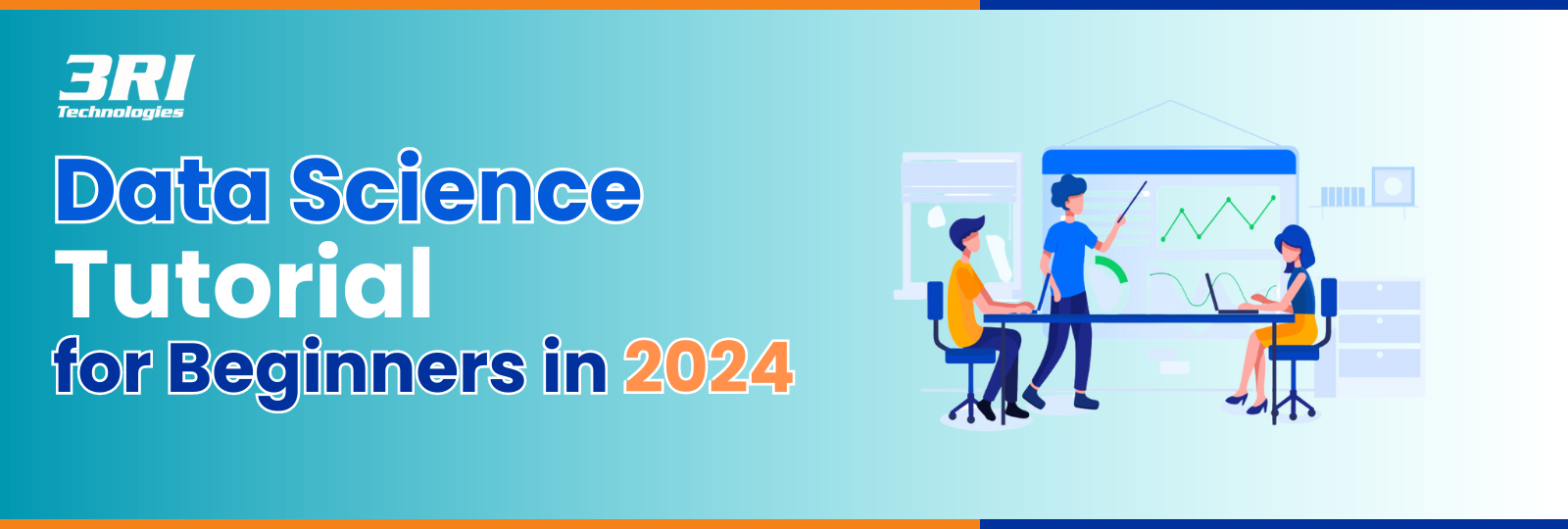Are you prepared to begin an exciting adventure into the realm of Data Science? In this Data Science Tutorial for Beginners in 2024, we will dive deep into the fundamentals of Data Science, explore the Data Science lifecycle, discuss prerequisites, understand the role of a Data Scientist, and provide you with a comprehensive overview of what this field entails.
Data Science is a dynamic and ever-changing profession with the ability to transform businesses and improve development. This blog will be your starting point to explore the basic ideas and techniques involved in Data Science, whether you are a new graduate, a professional interested in transforming professions, or simply curious about the world of data.
Unleash the potential of data through our all-encompassing Data Science course in Pune.

1. Introduction to Data Science
What Is Data Science?
Data Science is a specialized method to finding relevant information in data. It uses lots of different things like math, stats, computers, knowing a lot about a specific field, and working with data tools. Data Scientists use all these skills to look at data and help businesses and groups make smart choices based on data.
Why Data Science Matters
Making Smart Choices: Data Science helps groups make smart choices using facts, not just guesses.
Predicting the Future: It can predict what might happen in the future, like trends, what customers will do, and how markets will change.
Getting Better and Faster: Data Science makes things work better and faster by using computers to do tasks and make things run smoother.
Finding New Ideas: It helps us find new ideas, make new things, and offer new services. Learn data engineering skills from experts. only at Data Engineering Certification Course.
2. The Data Science Lifecycle
From Data to Insights
The Data Science lifecycle is a methodical approach to using data to address complex problems. It consists of several key stages:
Problem Definition: First, you need to understand the problem and defining clear objectives.
Data Collection: Collecting useful data from a variety of sources, such as Database servers, sensors, APIs, etc.,
Data Cleaning and Preprocessing: Ensuring that the data is correct, finalized, and ready for analysis.
Exploratory Data Analysis (EDA): Exploring data to obtain insights, uncover trends, and spot outliers.
Feature Engineering: Selecting and developing appropriate features for use in modeling.
Model Building: Developing machine learning models that can learn from the data to help you solve the problem, using algorithms and techniques.
Model Evaluation: The model’s performance is evaluated using metrics and validation methodologies and techniques.
Model Deployment: Implementing the model into production, making it accessible for decision-makers. For further information about our job-oriented courses, visit Job Oriented Course In Pune.
Key Stages in Data Science
It is typical practice in Data Science to iterate through stages in order to maximize results lifecycles, which are not necessarily linear. Each stage is essential to the ultimate success of a Data Science project.

Want Free Career Counseling?
Just fill in your details, and one of our expert will call you !
3. Data Science Prerequisites
The Foundation You Need
Before diving headfirst into Data Science, it is essential to build a strong foundation in certain areas:
Math: You need to understand stuff like numbers, how things change, and data patterns.
Computer Coding: You should be good at talking to computers in languages like Python or R, so you can use them to do Data Science solutions.
Domain Knowledge: Depending on your sector, having domain-specific expertise can provide you an advantage in data analysis and interpretation.
Essential Skills
In addition to the foundational knowledge, Data Scientists need a set of essential skills to excel in their roles:
Data Wrangling: The skill to take raw data, remove any errors or unnecessary information, preprocess (prepare it for analysis), and change it into a format that can be easily worked with.
Data Visualization: Creating visual representations such as charts and graphs of data to effectively communicate insights.
Machine Learning: Understanding and implementing various machine learning algorithms capable of predicting future outcomes based on data patterns.
Communication: Delivering facts and concepts in a way that non-experts in the field in a clear and understandable manner.
Problem-Solving: Approaching complex problems with a structured and analytical mindset.
Master the art of Data Analytics by enrolling in our Data Analytics Course In Pune.
4. Who Oversees the Data Science Process?
Collaborative Efforts
Data Science usually isn’t a one-person job. It’s a team effort with different people doing
In the world of Data Science, there are several key roles, each with its own unique responsibilities and skill sets. Here’s a breakdown of where you might fit in:

Get Free Career Counseling from Experts !
Data Scientist:
Your Role: Data Scientists are like the detectives of data. They analyze data to find patterns, make predictions, and solve complex problems.
Your Skills: You need to be good at statistics, programming (often using languages like Python or R), and machine learning. You also need domain knowledge to understand the data in context.
Your Focus: You work on building predictive models, finding insights in data, and helping organizations make data-driven decisions.
Data Analyst:
Your Role: Data analysts are like storytellers. They take data and turn it into understandable reports, visualizations, and narratives.
Your Skills: You should be good at examining data, using tools to make it easier to understand (like Tableau or Power BI), and have a basic grasp of statistics.
Your Focus: You focus on making data accessible and meaningful to non-technical stakeholders, helping them understand what the data is saying.
Data Engineer:
Your Role: Data engineers are like data plumbers. They build and maintain the infrastructure needed to store, process, and move data.
Your Skills: You should be really good at working with databases, the process of ETL (Extracting, Transforming, and Loading data), and usually, you will need to know about Big Data technologies like Hadoop or Spark.
Your Focus: Your primary focus is on ensuring data is collected, stored, and made available for analysis reliably and efficiently. Enroll in the Data Analyst course in Pune to master Data Analytics.
Domain Experts:
Your Role: Domain experts are specialists in a particular industry or field. They are familiar with the complexities and challenges of that industry.
Your Skills: Your expertise in your specific domain is invaluable. You don’t necessarily need strong technical skills, but you should be able to translate domain-specific problems into data-related questions.
Your Focus: You collaborate with Data Scientists and analysts to provide context for the data and help frame the right questions to address industry-specific challenges.
Business Analysts:
Your Role: Business analysts act as intermediaries between data professionals and non-technical business stakeholders.
Your Skills: You need a mix of business acumen and data understanding. Strong communication skills are crucial.
Your Focus: You bridge the gap between technical data professionals and business decision-makers, ensuring that data insights align with business objectives and needs.
Your fit in Data Science depends on your interests and strengths. If you enjoy digging deep into data and building models, Data Science might be your path. If you prefer working with data to create reports and visualizations, data analysis could be your niche. And if you have a knack for building and maintaining data systems, data engineering might be your calling. It’s also common for individuals to transition between these roles as their career evolves, so there’s flexibility to explore and grow in the field of Data Science
So, it’s often a whole team working together in Data Science.
In many organizations, Data Science is carried out by cross-functional teams that bring together a diverse set of skills. These teams work collaboratively to tackle complex challenges and drive innovation. Check out Data Science Online training and get certified today.

Do you want to book a FREE Demo Session?
5. What Is a Data Scientist?
The Mastermind Behind Data
A Data Scientist is a flexible expert with a special collection of skills and talents. They are often described as the “unicorns” of the data world because they can:
Analyze Data: Data Scientists are skilled in using statistical methods and machine learning algorithms to examine data, find patterns, and make predictions.
Generate Insights: They extract valuable insights from data, which can inform business strategies and decisions.
Build Models: Data Scientists create prediction models based on data to foresee future trends and resultant outcomes.
Communicate Findings: They can effectively communicate complex findings to non-technical stakeholders, enabling data-driven decision-making.
Roles and Responsibilities
The roles and responsibilities of a Data Scientist can vary based on the company and the project they’re working on. However, some common tasks include:
Data Collection: Gathering data from various sources and ensuring it is accurate and reliable.
Data Cleaning: Preprocessing data to remove errors and inconsistencies.
Exploratory Data Analysis: Exploring data to identify patterns and trends.
Model Building: Developing machine learning models to solve specific problems.
Model Evaluation: Assessing the performance of models and making improvements.
Deployment: Implementing models into production systems for real-time decision-making.

Book Your Time-slot for Counselling !
6. Data Science Tools and Technologies

Book Your Time-slot for Counselling !
Python and R
Python and R are the primary tools in the Data Science toolkit. They are popular because they are flexible, not too hard to learn, and come with lots of ready-made parts for working with data. If you’re just starting, you can pick either one to begin with, and if you want, you can learn the other later.
Python is famous for being simple to learn and work with. It has become the most popular choice for Data Science. It has helpers like NumPy, pandas, and Matplotlib that make it simple to play with data. Plus, there is a big community of people who are eager to help, and you can find tons of online guides and lessons.
On the other hand, R is famous for its math and stats powers. It has special tools like dplyr and ggplot2 that are awesome for messing around with data and making cool graphs. If you’re into data exploration, R can be a great pick.
Jupyter Notebooks
Think of Jupyter Notebooks as an interactive tool for working with data. It is like a special notepad on the web where you can write computer code and see the results right away. People in Data Science use it a lot to do things like look at data, make charts, and share their work with others.
One cool thing about Jupyter Notebooks is that you can mix up your code with explanations and visulaizations all in one place. It’s like writing a story where you can also show your calculations. This makes it super useful for showing how you did your data work, sharing discoveries with colleagues, and making reports with data.
And here’s another neat trick: Jupyter Notebooks can understand lots of different computer languages, not just one. So, if you like, you can use it for different jobs, whether you’re working with Python, R, Julia, or other coding languages. Their adaptability makes them a useful tool for Data Scientists.
Libraries and Frameworks
Data Science libraries and frameworks provide pre-built tools and functions for common data tasks. Some essential libraries include:
NumPy: For numerical computation and efficient array handling.
Pandas: For data manipulation and analysis.
Matplotlib: For creating static, animated, or interactive visualizations.
Scikit-learn: For machine learning tasks like classification, clustering, regression, and more.
TensorFlow and PyTorch: For deep learning and neural networks.
These libraries make it easier to build complex Data Science algorithms. For instance, Scikit-learn offers a wide range of machine learning models ready for use, while TensorFlow and PyTorch provide the backbone for deep learning projects.
A Data Scientist must be proficient in these tools and libraries. As you progress in your Data Science journey, you will find yourself relying on them extensively for various tasks, from data preprocessing to model building.

Meet the industry person, to clear your doubts !
7. Data Collection and Preprocessing
Data Sources
Data can be collected from various sources, including:
Structured Data: Relational databases, CSV files.
Unstructured Data: Text, images, videos, social media.
Web Scraping: Extracting data from websites.
APIs: Accessing data from online services.
Structured data, typically organized in rows and columns, is commonly found in databases and spreadsheet files. This format is well-suited for traditional data analysis and modeling tasks.
Unstructured data, on the other hand, presents its own set of challenges. This category includes text data, images, and multimedia. Natural language processing (NLP) techniques are used to extract insights from text data, whereas image and video analysis is done with computer vision technology.
Web scraping is the automated retrieval of information from websites. It is a valuable skill for gathering information that isn’t readily available in structured formats.
APIs (Application Programming Interfaces) provide a structured way to access data from online sources, such as social media platforms, financial databases, weather services, etc., They allow Data Scientists to retrieve up-to-date information for analysis.
Data Collection Methods
Surveys and Questionnaires: Gathering data through direct inquiries.
Observations: Collecting data by observing subjects.
Experiments: Controlled studies to collect data.
Sensor Data: Gathering data from sensors and IoT devices.
Surveys and questionnaires are commonly used to gather data from individuals or groups. They are valuable for collecting opinions, preferences, and feedback.
Observations involve systematically recording information by observing subjects or events. This method is often used in fields like biology, psychology, and social sciences.
Experiments are controlled studies designed to investigate specific hypotheses. They allow researchers to manipulate variables to understand cause-and-effect relationships.
Sensor data is generated by sensors, such as those in weather stations or Internet of Things (IoT) devices. These sensors collect data on temperature, humidity, pressure, and more. Analyzing sensor data can provide insights into various domains, from environmental monitoring to industrial processes.
Data Cleaning and Preprocessing
To ensure data quality and usability, it must be cleaned and preprocessed prior to analysis. This includes:
Handling Missing Data: Dealing with null or missing values in the dataset. Two common methods are the removal of incomplete records and imputation (filling missing data with estimates).
Data Transformation: Scaling, normalizing, or encoding data as needed. For example, in machine learning, it’s often necessary to scale features to have similar magnitudes to prevent certain algorithms from dominating others.
Outlier Detection: discovering and dealing with outliers that could hinder analyses. Model performance can be impacted by outliers, which can skew statistical metrics. Detecting and handling outliers is crucial for robust data analysis.
Feature Engineering: Providing new features based on the already-available data to improve model performance.
Feature engineering involves selecting, modifying, or creating variables that enhance the predictive power of machine learning models.
Data preprocessing and cleaning are iterative processes requiring technical expertise as well as the domain knowledge. A well-pre-processed dataset lays the foundation for accurate and meaningful analysis.

Get FREE career counselling from Experts !
8. Exploratory Data Analysis (EDA)
Understanding Your Data
Exploratory Data Analysis (EDA) is a crucial step in Data Science that involves:
Summary Statistics: Calculating basic statistics to describe the dataset. Common statistics include measures of central tendency (mean, median) and measures of variability (standard deviation, range).
Data Visualization: Plotting and charting data to show trends. Visualization is a powerful method for identifying trends, outliers, and connections between variables.
Hypothesis Testing: Conducting statistical tests to validate assumptions or hypotheses about the data. Hypothesis testing is used to determine whether observed differences or trends are of statistical significance.
Correlation Analysis: Determining relationships between various factors. The strength and direction of relationships between two or more variables are measured through correlation.
Data Scientists that use exploratory data analysis can better comprehend the dataset they are using. It helps uncover insights, discover patterns, and generate hypotheses for further investigation.
Data Visualization
Data visualization is crucial to both data communication and EDA. Visualizations help you convey information effectively and enable you to:
Spot Trends: Line charts can reveal trends over time, while scatter plots can display relationships between variables.
Identify Outliers: Box plots and scatter plots can be used to show data points that deviate from the norm.
Compare Distributions: Histograms and density plots show the distribution of data values.
Communicate Findings: With the use of well-designed visualizations, complex data can be streamlined and made accessible to non-technical stakeholders.
A variety of tools are available for building insightful and visually appealing representations in well-known data visualization frameworks like Matplotlib, Plotly, and Seaborn.
Descriptive Statistics
Data are summarized using descriptive statistics, which also include measurements of central tendency and variability:
Measures of Central Tendency: These statistics indicate where the center of the data is located. The mean (average), median (middle value), and mode (most common value) are common measures.
Measures of Variability: These statistics quantify the spread or dispersion of data. Common measures include the standard deviation (a measure of data’s variability around the mean) and the range (the difference between the maximum and minimum values).
Descriptive statistics are typically used to provide an overview of the data. They can help identify potential issues, such as extreme values or skewed distributions, which may require further investigation during the data cleaning and preprocessing stage
Gain knowledge from industry experts by visiting 3RI Technologies.
Conclusion
In conclusion, Data Science is a broad field with a lot of opportunities for anyone who are interested in learning more about it. A fondness for learning from data, dedication, and continual education are required for the journey. Whether you are a student, a professional, or someone simply curious about data, the world of Data Science tutorial for beginners free welcomes you to its exciting realm of possibilities.
This Data Science Tutorial Free for Beginners in 2024 has provided you with a comprehensive overview of the field, from its fundamentals to advanced topics. As you continue your Data Science Journey, remember that practice and hands-on experience are key to mastering the art of data analysis and modeling. Stay curious, keep learning, and embrace the data-driven future. Good luck on your Data Science journey!

